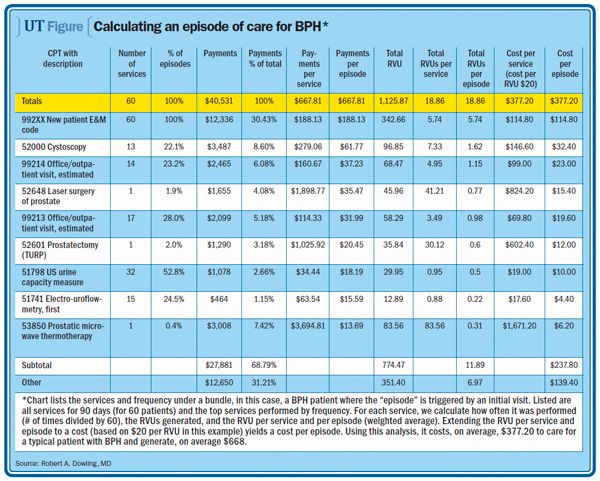Article
Bundled payments are coming; how to prepare
In this column, Robert A. Dowling, MD, explores bundled payments and describes a method for calculating “costs” that a practice could use to determine profit/loss projections and negotiate fee schedules using relative value units.

Last fall, I wrote about the importance of understanding the “cost of care” (“How new payment models will redefine ‘cost of care’,” October 2013) when considering emerging reimbursement models. In that article, I outlined cost accounting as one approach to prepare for alternate payment models such as discounted fee for service and bundled payments.
This month, I explore bundled payments further, and describe a second method for calculating “costs” that a practice could use to determine profit/loss projections and negotiate fee schedules using relative value units (RVUs).
Several advantages of bundled payments
According to Ellis Knight, MD, chief medical officer of the Coker Group, bundled payments have the potential to improve care by promoting care coordination, best practices, and data-driven performance improvement. Also, a bundled payment can potentially lower the cost of care by eliminating waste and inefficiency and promoting a connection between “price” and “cost.” Examples of different models include fee for service with shared savings, or a single payment made to an entity that can absorb risk (such as an accountable care organization).
Dr. Knight stresses that in order to succeed with a bundled model, an organization should have a robust information technology infrastructure, be clinically integrated, and have a care management platform and/or disease management approach. Most organizations that meet these requirements are larger than the typical urology practice, but urologists will need to understand these concepts to participate in reimbursement models beyond “fee for service.”
So how can a urology practice prepare for bundled payments at the dawn of alternative payment models? The best preparation will come from a detailed understanding of current “costs”-meaning the expenses incurred by the practice to see patients, generate revenue, and manage the business.
One way to conceptualize bundled payments is to consider a common patient with a common problem and construct an “episode of care” around that patient-problem. In the aforementioned article, I discussed breaking down expenses for an annual episode of testosterone replacement therapy using a cost accounting method. Another approach might be to use a reference benchmark like RVUs as a surrogate for costs. (If you aren’t familiar with RVUs, see http://ow.ly/yeIkK). Most, but not all services conducted within a urology practice have been assigned a relative value unit that is proportional to the amount of physician work, practice expense, and malpractice expense involved in rendering that service.
Each year, the Centers for Medicare & Medicaid Services publishes, as part of its physician fee schedule, a list of RVUs for each service (http://ow.ly/yeIum). This schedule can be imported automatically, or manually, into your practice management system (often by the vendor) and used to track RVUs in your practice. Then you can determine “costs per RVU” by dividing the total practice overhead (do not include physician compensation) by the total number of RVUs. The Medical Group Management Association has benchmarks for cost/work RVU and cost/total RVU, but these figures are based on a small number of surveyed practices and may not be generalizable to your practice.
Know what services to include in bundle
Next, you need to understand what services to include in the bundle or “episode of care.” For example, if you were constructing a model for BPH patients, you might want to include the initial visit and subsequent services within 90 days in your “episode.” To understand your historical experience with these types of patients, you can mine your practice management data and determine all the services you typically render to your patients after a new patient visit where BPH is the principal diagnosis, and with what frequency. Each service can then be assigned a “cost” based on RVUs, and extended to a cost per episode. That analysis might look like the example depicted by the figure below.

From this analysis, based on actual experience with 60 patients in a year, it costs, on average, $377.20 to “care for” a typical patient with BPH and generate, on average $668.
The “episode of care” calculation is also an excellent opportunity to consider clinical pathways and standardizing what constitutes a best “episode” in your practice. Compare your service line analysis with clinical algorithms to see how often an episode matches up with best practice. Eliminating unnecessary services and reducing variability are the best opportunities for reducing cost and thereby increasing profits under bundled payment (fixed revenue/episode) models.
Bottom line: Choose a method for determining the expenses associated with providing care in your practice. Once armed with this information, you will be better prepared to approach payers who are interested in alternate payment models and understand whether you can afford to participate or even thrive in those arrangements.UT
More "Bottom Line" articles
EHRs: Costly replacement or ‘disruptive innovation’?
OIG focuses on provider status, admission criteria
Initiatives open up patient access to their health info
Subscribe to Urology Times to get monthly news from the leading news source for urologists.
Newsletter
Stay current with the latest urology news and practice-changing insights — sign up now for the essential updates every urologist needs.

















